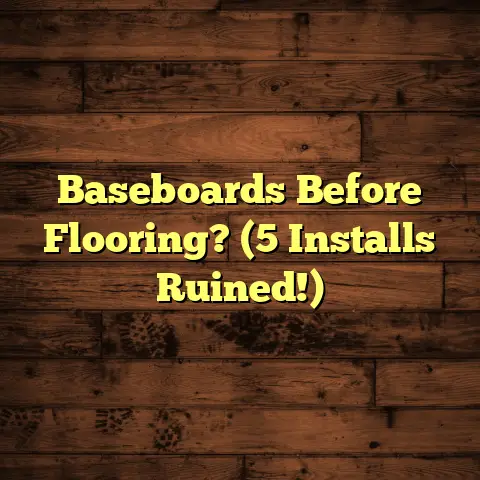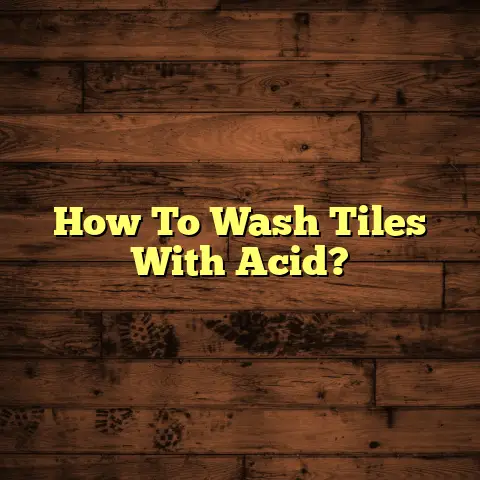What To Clean Epoxy Floors With? (3 Secrets!)
These floors are becoming crazy popular, and for good reason. But what most people don’t realize is that the real magic of epoxy goes way beyond just looking good. Let’s dive in!
Introduction: Hidden Benefits of Epoxy Floors
I’ve been in the flooring business for over 15 years, and I’ve seen trends come and go. But epoxy? Epoxy is here to stay.
It’s not just about the sleek, modern look – although that’s definitely a perk. The real hidden benefits of epoxy floors are their insane durability, resistance to just about everything you can throw at them (stains, chemicals, you name it), and their surprisingly low-maintenance nature.
Think about it: you install an epoxy floor in your garage, and suddenly you’re not constantly battling oil stains, tire marks, or cracking concrete. In a commercial setting, epoxy can stand up to forklifts, dropped tools, and constant foot traffic without showing its age.
And guess what? Proper cleaning and maintenance are the key to unlocking these benefits and making them last. Neglecting your epoxy floor is like buying a Ferrari and never changing the oil. You’re just asking for trouble down the road.
That’s why I’m going to share my top 3 secrets to cleaning epoxy floors, so you can keep yours looking great for years.
Here’s what we’ll cover:
-
Understanding Epoxy Flooring: What it is, the different types, and why it’s so awesome.
-
Common Challenges: Stains, scratches, and the dreaded dust bunnies.
-
Secret 1: The right cleaning solutions (and what to avoid like the plague).
-
Secret 2: The best cleaning tools for the job.
-
Secret 3: Effective cleaning techniques that will save you time and effort.
Ready to get started? Let’s jump in!
Section 1: Understanding Epoxy Flooring
Okay, so before we get into the nitty-gritty of cleaning, let’s make sure we’re all on the same page about what epoxy flooring actually is.
1.1 What is Epoxy Flooring?
Epoxy flooring isn’t just some fancy paint you slap on your concrete. It’s a system. It involves applying one or more layers of epoxy resin to a properly prepared surface.
Epoxy resin is a thermosetting polymer that, when mixed with a hardener or catalyst, undergoes a chemical reaction that cures the resin into a rigid plastic material. This results in a durable, seamless, and chemical-resistant surface.
Think of it like this: you’re essentially creating a protective shield over your existing floor.
Types of Epoxy Floors
There are several types of epoxy floors, each with its own unique properties and applications. Here are a few of the most common:
-
Self-Leveling Epoxy: This type is designed to create a smooth, level surface. It’s perfect for floors that are slightly uneven or damaged.
-
Epoxy Mortar: This is the heavy-duty option. It’s made by mixing epoxy resin with aggregates like sand or quartz, creating a super-strong and impact-resistant floor.
-
Quartz Epoxy: This type incorporates quartz sand into the epoxy, providing a decorative and slip-resistant finish.
-
Epoxy Flake: This is where things get really interesting aesthetically. Colored flakes are broadcast into the epoxy before it cures, creating a vibrant and textured look.
-
Metallic Epoxy: This type uses metallic pigments to create a stunning, shimmering effect. It’s often used in high-end retail spaces and showrooms.
The type of epoxy floor you have will influence, to some extent, the cleaning methods you should use. But the core principles remain the same.
1.2 Benefits of Epoxy Floors
Alright, let’s talk about why epoxy floors are so darn popular. I mentioned the aesthetic appeal earlier, but the benefits go way beyond just looks.
Durability and Strength
Epoxy floors are incredibly durable and strong. They can withstand a ton of abuse, making them ideal for high-traffic areas like garages, warehouses, and retail stores.
I’ve seen epoxy floors in auto repair shops that have been subjected to dropped tools, spilled fluids, and the constant weight of cars and trucks. And they still look fantastic years later!
According to a study by the American Concrete Institute, epoxy coatings can increase the compressive strength of concrete by up to 30%. That’s a significant improvement!
Resistance to Wear and Tear
Epoxy floors are also highly resistant to wear and tear. They won’t easily crack, chip, or peel, even under heavy use. This makes them a great investment for businesses that want a floor that will last.
They’re also resistant to many chemicals, oils, and other substances that can damage other types of flooring. This is especially important in industrial settings where spills are common.
Ideal for High-Traffic Areas
As I’ve mentioned, epoxy floors are perfect for high-traffic areas. Their durability and resistance to wear and tear mean they can stand up to a lot of abuse without showing their age.
I’ve installed epoxy floors in shopping malls, airports, and hospitals, all of which see a massive amount of foot traffic every day. And in each case, the epoxy floor has performed exceptionally well.
1.3 The Importance of Proper Cleaning
So, you’ve got an epoxy floor. Congrats! But don’t think you can just ignore it and expect it to stay looking great forever. Regular cleaning is essential to maintaining the integrity and appearance of your epoxy floor.
Think of it like this: you wouldn’t buy a fancy car and never wash it, right? The same principle applies to epoxy floors. Regular cleaning helps to remove dirt, dust, and other debris that can scratch or dull the surface.
It also helps to prevent stains from setting in. The sooner you clean up a spill, the less likely it is to leave a permanent mark.
And, of course, proper cleaning helps to keep your epoxy floor looking its best. A clean, shiny floor can make a huge difference in the overall appearance of your space.
That’s why I’m going to share my “three secrets” to cleaning epoxy floors. These secrets will help you keep your floor looking great for years to come.
Section 2: Common Challenges with Epoxy Floors
Okay, let’s be real. Epoxy floors are tough, but they’re not completely invincible. There are a few common challenges that you’ll need to be aware of.
2.1 Stains and Spills
One of the biggest challenges with epoxy floors is stains and spills. While epoxy is resistant to many substances, certain things can still leave a mark if not addressed promptly.
Common Sources of Stains
Here are a few of the most common culprits:
-
Oil: Oil spills from cars or machinery can be tough to remove if left to sit.
-
Paint: Paint spills can also be difficult to clean up, especially if they’re allowed to dry.
-
Food: Food spills, especially those that are acidic or contain dyes, can stain epoxy floors.
-
Chemicals: Certain chemicals, such as strong acids or solvents, can damage or stain epoxy.
The key is to act quickly. The sooner you clean up a spill, the less likely it is to leave a permanent stain.
2.2 Scratches and Scuffs
Another common challenge with epoxy floors is scratches and scuffs. While epoxy is durable, it’s not completely scratch-proof.
How Scratches and Scuffs Occur
Heavy furniture, equipment, or even just regular foot traffic can cause scratches and scuffs on epoxy flooring. Dragging heavy objects across the floor is a surefire way to damage the surface.
Preventive Measures
Fortunately, there are a few things you can do to minimize scratches and scuffs:
-
Use Furniture Pads: Place felt pads under the legs of furniture to prevent them from scratching the floor.
-
Avoid Dragging Heavy Objects: Always lift heavy objects when moving them across the floor.
-
Use a Protective Mat: Place a protective mat in high-traffic areas to prevent wear and tear.
2.3 Dirt and Dust Accumulation
Finally, dirt and dust accumulation can be a challenge with epoxy floors. While epoxy is easy to clean, dust and dirt can still build up on the surface and affect the appearance of the floor.
Why Regular Cleaning is Important
Regular cleaning is essential to prevent dirt and dust from accumulating. A quick sweep or mop can go a long way in keeping your epoxy floor looking its best.
The Impact on Appearance
Dirt and dust can dull the shine of your epoxy floor, making it look less vibrant and appealing. Regular cleaning will help to maintain the floor’s glossy finish.
Okay, now that we’ve covered the common challenges with epoxy floors, let’s get into the good stuff: the secrets to cleaning them!
Section 3: Secret 1 – The Right Cleaning Solutions
Alright, let’s dive into the first secret: using the right cleaning solutions. This is a big one, because using the wrong cleaner can actually damage your epoxy floor.
3.1 Recommended Cleaners for Epoxy Floors
So, what should you use to clean your epoxy floor? Here are a few of my top recommendations:
-
pH-Neutral Cleaners: These are the safest and most effective cleaners for epoxy floors. They won’t damage the surface or leave behind any residue.
-
Mild Detergents: A mild detergent, like dish soap, can also be used to clean epoxy floors. Just make sure to dilute it properly with water.
-
Ammonia: Diluted ammonia can be effective for removing grease and grime from epoxy floors. However, it should be used sparingly and with proper ventilation.
Cleaners to Avoid
Now, let’s talk about what not to use on your epoxy floor. Here are a few cleaners to avoid like the plague:
-
Acidic Cleaners: Acidic cleaners, like vinegar or lemon juice, can damage the surface of your epoxy floor.
-
Abrasive Cleaners: Abrasive cleaners, like scouring pads or steel wool, can scratch the surface of your epoxy floor.
-
Solvent-Based Cleaners: Solvent-based cleaners, like acetone or paint thinner, can dissolve or damage epoxy.
-
Soap-Based Cleaners: Soap-based cleaners can leave a film on the epoxy floor, making it look dull over time.
3.2 DIY Cleaning Solutions
If you’re looking for a more natural and eco-friendly option, you can also make your own DIY cleaning solutions for epoxy floors.
Here are a couple of my favorite recipes:
-
Baking Soda Paste: Mix baking soda with water to create a paste. Apply the paste to stains and let it sit for a few minutes before wiping it away.
-
Borax Solution: Mix 1/2 cup of borax with 1 gallon of water. Use the solution to mop your epoxy floor.
Benefits of Natural Ingredients
Using natural ingredients has several benefits:
-
They’re Safe: Natural ingredients are generally safe for your family, pets, and the environment.
-
They’re Effective: Natural ingredients can be just as effective as commercial cleaners at removing dirt and grime.
-
They’re Affordable: Natural ingredients are often less expensive than commercial cleaners.
Alright, now that you know which cleaning solutions to use (and which to avoid), let’s move on to the second secret: using the best cleaning tools.
Section 4: Secret 2 – The Best Cleaning Tools
Okay, so you’ve got your cleaning solutions sorted out. But having the right tools is just as important. Using the wrong tools can damage your epoxy floor, or simply make the cleaning process more difficult.
4.1 Essential Cleaning Tools
Here are a few essential cleaning tools that every epoxy floor owner should have:
-
Microfiber Mop: Microfiber mops are gentle on epoxy floors and do a great job of picking up dirt and dust.
-
Soft-Bristle Broom: A soft-bristle broom is perfect for sweeping up loose debris before mopping.
-
Squeegee: A squeegee can be used to remove excess water after mopping, preventing water spots.
The Importance of Non-Abrasive Tools
It’s crucial to use non-abrasive tools when cleaning epoxy floors. Abrasive tools, like steel wool or scouring pads, can scratch the surface of the floor and leave it looking dull.
4.2 Specialized Equipment
If you’re looking to take your epoxy floor cleaning to the next level, you might consider investing in some specialized equipment.
Here are a couple of options:
-
Floor Scrubber: A floor scrubber can make quick work of cleaning large epoxy floors. It uses rotating brushes to scrub the floor and a vacuum to suck up the dirty water.
-
Steam Cleaner: A steam cleaner can be used to deep clean epoxy floors without the need for harsh chemicals. The steam loosens dirt and grime, which can then be wiped away.
Benefits of Professional Equipment
Using professional cleaning equipment can offer several benefits:
-
Enhanced Cleaning: Professional equipment can provide a more thorough and effective cleaning than manual methods.
-
Time Savings: Professional equipment can significantly reduce the amount of time it takes to clean your epoxy floor.
-
Better Results: Professional equipment can help you achieve better results, leaving your epoxy floor looking its best.
Okay, now that you know which tools to use, let’s move on to the third and final secret: effective cleaning techniques.
Section 5: Secret 3 – Effective Cleaning Techniques
Alright, we’ve covered the right cleaning solutions and the best cleaning tools. Now it’s time to put it all together and talk about how to actually clean your epoxy floor.
5.1 Step-by-Step Cleaning Process
Here’s a step-by-step guide to cleaning epoxy floors effectively:
-
Sweep the Floor: Use a soft-bristle broom to sweep up any loose debris, such as dirt, dust, or crumbs.
-
Prepare Your Cleaning Solution: Mix your chosen cleaning solution with water according to the manufacturer’s instructions.
-
Mop the Floor: Dip your microfiber mop into the cleaning solution and wring out the excess water. Mop the floor in overlapping strokes, making sure to cover the entire surface.
-
Rinse the Floor (Optional): If desired, you can rinse the floor with clean water to remove any remaining cleaning solution.
-
Dry the Floor: Use a squeegee or clean, dry towels to dry the floor. This will help to prevent water spots.
Frequency of Cleaning
How often should you clean your epoxy floor? It depends on how much traffic it gets and how dirty it gets.
In general, I recommend sweeping your epoxy floor at least once a week and mopping it every two to four weeks. If you have a lot of traffic or spills, you may need to clean it more often.
Tackling Tough Stains
What about those tough stains that just won’t come out? Here are a few tips for tackling them:
-
Act Quickly: The sooner you address a stain, the easier it will be to remove.
-
Use a Baking Soda Paste: As mentioned earlier, a baking soda paste can be effective for removing many types of stains.
-
Try a Degreaser: For oil or grease stains, try using a degreaser specifically designed for epoxy floors.
-
Call a Professional: If you’ve tried everything else and the stain still won’t come out, it may be time to call a professional cleaning service.
5.2 Maintenance Tips
In addition to regular cleaning, there are a few other maintenance tips that can help keep your epoxy floor looking its best:
-
Use Protective Mats: Place protective mats in high-traffic areas to prevent wear and tear.
-
Use Furniture Pads: Place felt pads under the legs of furniture to prevent them from scratching the floor.
-
Avoid Dragging Heavy Objects: Always lift heavy objects when moving them across the floor.
-
Apply a Protective Coating: Consider applying a protective coating to your epoxy floor every few years. This will help to protect the surface from scratches and stains.
Alright, that’s it! You’ve now learned my three secrets to cleaning epoxy floors.
Section 6: Conclusion
Let’s recap everything and bring it all together.
6.1 Recap of Benefits
We started by discussing the hidden benefits of epoxy flooring, including its durability, resistance to stains and chemicals, and aesthetic appeal.
We then talked about the importance of proper cleaning and maintenance to unlock these benefits and prolong the life of your epoxy floor.
Finally, we dove into my three secrets to cleaning epoxy floors:
-
Secret 1: Using the right cleaning solutions.
-
Secret 2: Using the best cleaning tools.
-
Secret 3: Using effective cleaning techniques.
6.2 Encouragement to Adopt Best Practices
I hope this article has been helpful and informative. I encourage you to implement these cleaning secrets in your own home or business.
By following these best practices, you can keep your epoxy floor looking its best for years to come. Trust me, a little bit of effort now will save you a lot of time and money in the long run.
So go ahead, give your epoxy floor the love and attention it deserves. You’ll be amazed at the difference it makes!





